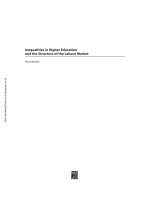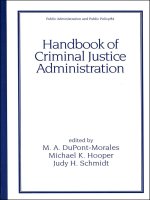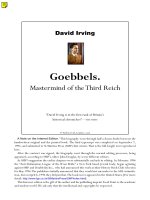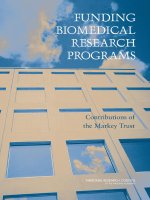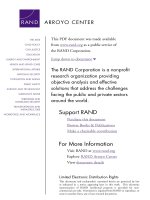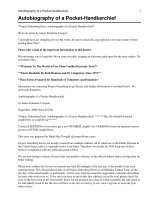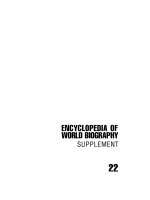PHENOTYPIC CHARACTERIZATION OF ANIMAL GENETIC RESOURCES pdf
Bạn đang xem bản rút gọn của tài liệu. Xem và tải ngay bản đầy đủ của tài liệu tại đây (1.61 MB, 158 trang )
guidelines
ISSN 1810-0708
11
FAO ANIMAL PRODUCTION AND HEALTH
11 FAOPhenotypic characterization of animal genetic resources
-
The Global Plan of Action for Animal Genetic Resources, adopted in 2007, is the
first internationally agreed framework for the management of biodiversity in the
livestock sector. It calls for the development of technical guidelines to support
countries in their implementation efforts. Guidelines on the Preparation of
national strategies and action plans for animal genetic resources were published
by FAO in 2009 and are being complemented by a series of guideline publications
addressing specific technical subjects.
These guidelines on Phenotypic characterization of animal genetic resources
address Strategic Priority Area 1 of the Global Plan of Action – “Characterization,
inventory and monitoring of trends and associated risks”. They complement, in
particular, the guidelines on molecular genetic characterization and on surveying
and monitoring of animal genetic resources. They have been endorsed by the
Commission on Genetic Resources for Food and Agriculture.
The guidelines offer advice on how to conduct a well-targeted and cost-effective
phenotypic characterization study that contributes to the improvement of animal
genetic resources management in the context of country-level implementation of
the Global Plan of Action. An overview of the concepts and approaches that
underpin phenotypic characterization is followed by practical guidance on
planning and implementing field work, data management and data analysis. The
annexes include generic data collection formats for phenotypic characterization
of major livestock species, as well as a framework for recording data on breeds’
production environments.
PHENOTYPIC
CHARACTERIZATION OF
ANIMAL GENETIC RESOURCES
FAO ANIMAL PRODUCTION AND HEALTH
11
guidelines
FOOD AND AGRICULTURE ORGANIZATION OF THE UNITED NATIONS
Rome, 2012
PHENOTYPIC
CHARACTERIZATION OF
ANIMAL GENETIC RESOURCES
Recommended citation
FAO. 2012. Phenotypic characterization of animal genetic resources.
FAO Animal Production and Health Guidelines No. 11. Rome.
The designations employed and the presentation of material in this
information product do not imply the expression of any opinion whatsoever
on the part of the Food and Agriculture Organization of the United Nations
(FAO) concerning the legal or development status of any country, territory, city
or area or of its authorities, or concerning the delimitation of its frontiers or
boundaries. The mention of specific companies or products of manufacturers,
whether or not these have been patented, does not imply that these have
been endorsed or recommended by FAO in preference to others of a similar
nature that are not mentioned.
The views expressed in this information product are those of the author(s) and
do not necessarily reflect the views of FAO.
ISBN 978-92-5-107199-1
All rights reserved. FAO encourages reproduction and dissemination of
material in this information product. Non-commercial uses will be authorized
free of charge, upon request. Reproduction for resale or other commercial
purposes, including educational purposes, may incur fees. Applications for
permission to reproduce or disseminate FAO copyright materials, and all
queries concerning rights and licences, should be addressed by e-mail to
or to the Chief, Publishing Policy and Support Branch,
Office of Knowledge Exchange, Research and Extension, FAO,
Viale delle Terme di Caracalla, 00153 Rome, Italy.
© FAO 2012
iii
Contents
Abbreviations and acronyms vii
Acknowledgments ix
Preamble xi
Introduction 1
Rationale 1
Background and development of the guidelines 2
User guidance 2
SECTION A
Conceptual framework 7
What is phenotypic characterization? 9
Non-descript populations 9
The breed concept 10
Approaches to characterization 12
Quantitative procedures for breed identification 14
Constituents of phenotypic characterization 16
SECTION B
Operational framework 27
Establish an inventory of stakeholders 29
Establish the study team 30
Collect background information 32
Clarify the objectives and scope of the study 34
SECTION C
Data collection for primary characterization 37
Develop the sampling frame 39
Prepare the data-collection equipment and methods 41
Prepare the protocol for data collection 46
Train the enumerators and their supervisors 47
Pilot and pre-test the study instruments 47
Organize the logistics of the field work 48
Finalize the plan for data collection 48
iv
SECTION D
Data collection for advanced characterization 49
Review objectives and scope 51
Develop the sampling frame 52
Prepare the tools for data collection 53
Prepare the protocol for data collection 56
Train livestock keepers or enumerators and their supervisors 56
Pilot and pre-test the study instruments 57
Organize the logistics of the fieldwork 57
Finalize the plan for the data collection 58
SECTION E
Data management and analysis 59
Data management 61
Data analysis 64
SECTION F
Reporting and communication 71
Interim progress reports 73
The final report 74
Additional communications products 77
The way forward – incorporating the outputs into future work 77
References and annexes 81
References 83
Annex 1 –
Checklist for phenotypic characterization of cattle 87
General guidelines 87
Discrete or qualitative variables 87
Quantitative variables 88
Herd-level data 88
Data related to origin and development 89
Data collected on traits that require repeated measurements 89
Illustrations 91
Annex 2 –
Checklist for phenotypic characterization of sheep and goats 95
General guidelines 95
Discrete or qualitative variables 95
Quantitative variables 96
Flock-level data 96
v
Data related to origin and development 97
Data collected on traits that require repeated measurements 98
Illustrations 99
Annex 3 –
Checklist for phenotypic characterization of chickens 107
General guidelines 107
Discrete or qualitative variables 107
Quantitative variables 107
Flock-level data 108
Data related to origin and development 108
Data collected on traits that require repeated measurements 109
Illustrations 110
Annex 4 –
Checklist for phenotypic characterization of pigs 115
General guidelines 115
Discrete or qualitative variables 115
Quantitative variables 115
Herd-level data 116
Data related to origin and development 116
Data collected on traits that require repeated measurements 117
Illustrations 118
Annex 5 –
Production environment descriptors 123
Part I:
General 123
Part II:
Natural Environment 123
Part III:
Management Environment 126
Part IV:
Socio-economic characteristics 128
Part V:
Breeds’ special qualities 130
Annex 6 –
Definition of terms 131
Quantitative variables for body measurements 131
Dentition classes of goats 131
Estimates of age of sheep and goats from dentition 132
Description of body condition scores 132
Chicken plumage descriptors 132
Production environment descriptors 134
vi
BOXES
1 A breed improvement scheme based on insufficient characterization
information – the case of Bolivian Criollo sheep 4
2 Definitions of breed categories and related terms 11
3 A rapid method of assessing milk production in cattle breeds 19
4 How to complement genetic characterization with phenotypic
characterization – an example 20
5 Aggregated productivity model for comparative performance
evaluation of AnGR 25
6 Selected surveying tools for collecting AnGR-related data 33
7 Use of advanced characterization for designing breed
improvement – the case of Thin-tailed Sumatra sheep 35
8 Estimating the of age of sheep and goats from their dentition 40
9 Simple example for determining sample size 42
10 Choosing the statistical methods according to the purpose of the
characterization study 69
11 A checklist for reporting on the data analysis 76
TABLES
1 Examples of national and local, regional and international
stakeholders 29
2 Statistical methods for characterization studies 68
3 What makes a good research report? 75
4 Communication methods – strengths and weaknesses 78
FIGURES
1 Structure of the guidelines 5
2 Operational framework for phenotypic characterization studies 31
vii
Abbreviations and acronyms
ACSAD Arab Center for Studies of Arid Zones and Dry Areas
AnGR animal genetic resources for food and agriculture
AOAD Arab Organization for Agricultural Development
DAD-IS Domestic Animal Diversity Information System
DNA deoxyribonucleic acid
FABISNet Farm Animal Biodiversity Information System Network
FPC finite population correction
GPS global positioning system
ICARDA International Center for Agricultural Research in the Dry Areas
IFAD International Fund for Agricultural Development
IICA Inter-American Institute for Cooperation on Agriculture
ILRI International Livestock Research Institute
ISAG International Society for Animal Genetics
NGO non-governmental organization
OECD Organisation for Economic Co-operation and Development
OTU operational taxonomic unit
PED production environment descriptor
SADC Southern Africa Development Community
SAHN sequential, agglomerative, hierarchic and non-overlapping
SPC Secretariat of the Pacific Community
STT Thin-tailed sheep of Sumatra
WB World Bank
ix
Acknowledgments
The preparation of these guidelines began in 2008 under the supervision of Badi Besbes. Ini-
tial work was undertaken by Manuel Luque Cuesta. Workneh Ayalew produced a new draft
version of the guidelines, which was presented and discussed at workshops held in Argen-
tina, Senegal and Italy. These workshops were attended by 100 scientists, technicians and
policy-makers. A revised and updated draft was prepared by Badi Besbes, Workneh Ayalew
and Dafydd Pilling. Text boxes were provided by Luis Iñiguez and Evangelina Rodero Serrano.
The illustrations were prepared by Antje Weyhe. FAO would like to express its thanks to all
these individuals and to all those not mentioned here who generously contributed their time,
energy and expertise. The guidelines were presented to and endorsed by the Commission on
Genetic Resources for Food and Agriculture at its Thirteenth Regular Session in July 2011.
xi
Preamble
These guidelines are part of a series of publications produced by FAO to support countries in
the implementation of the Global Plan of Action for Animal Genetic Resources. While each
of these publications addresses a different aspect of the management of animal genetic
resources for food and agriculture (AnGR), they should be utilized in conjunction. The guide-
lines on phenotypic characterization fall within Strategic Priority Area 1 of the Global Plan
of Action, which is also being addressed by two other guideline publications: one focusing
on surveying and monitoring of AnGR and the other on molecular characterization. The
guidelines on surveying and monitoring (FAO, 2011a) present the “big picture” – describing
how to plan a national strategy for obtaining AnGR-related data and keeping them up to
date; they introduce the various types of survey that may form part of such a strategy, and
outline the main steps involved in planning and implementing a survey. The guidelines on
phenotypic characterization describe how to conduct a study on a specific animal popula-
tion and its production environment – including details of what to measure, how to take
these measurements and how to interpret them. The guidelines on molecular characteriza-
tion (FAO, 2011b) provide advice on how to obtain and use DNA samples to support the
management of AnGR. Despite these differences in focus, there is inevitably some overlap
in the subject matter of the three publications.
1
Introduction
RATIONALE
Characterization of animal genetic resources for food and agriculture (AnGR) involves three
types of information: phenotypic, genetic and historical. The weight given to each depends
on the country (e.g. whether it is developed or developing) and the objective (e.g. improve-
ment, conservation or breed differentiation). These guidelines focus on the collection and
use of phenotypic information.
Phenotypic characterization of AnGR is the process of identifying distinct breed popula-
tions and describing their external and production characteristics in a given environment
and under given management, taking into account the social and economic factors that
affect them. The information provided by characterization studies is essential for planning
the management of AnGR at local, national, regional and global levels. The Global Plan of
Action for Animal Genetic Resources (FAO, 2007) recognizes that “A good understanding
of breed characteristics is necessary to guide decision-making in livestock development and
breeding programmes”. The Global Plan of Action’s Strategic Priority Area 1 is devoted to
“Characterization, Inventory and Monitoring of Trends and Associated Risks”.
Assessing the diversity of AnGR is made more difficult by the existence of many animal
populations that are not assigned to any recognized breed. Even though parts of these
“non-descript” populations are known to be multiple crosses of recognized breeds, some
animals may belong to (relatively) homogenous groups distinguishable from neighbouring
populations on the basis of identifiable and stable phenotypic characteristics (among which
may be unique and valuable attributes) that warrant their being distinguished as separate
breeds. Determining whether or not this is the case is one of the roles of phenotypic charac-
terization and is a prerequisite for effective assessment of AnGR diversity and determining
whether or not it is being eroded. Phenotypic characterization is therefore fundamental to
the establishment of national inventories of AnGR, to effective monitoring of AnGR popu-
lations and to the establishment of early-warning and response systems for AnGR.
Phenotypic characterization activities are technically and logistically challenging. Ensur-
ing that they are well targeted (collect data that are important to the country’s priority
AnGR- and livestock-development activities) and are carried out in an efficient and cost-
effective manner requires thorough planning and careful implementation. Valid compari-
sons among livestock breeds or populations, whether nationally or internationally, require
the development and use of standard practices and formats for describing their character-
istics. Such standards and protocols are also needed for assessing requests for the recogni-
tion of new breeds. The Global Plan of Action calls for the development of “international
technical standards and protocols for characterization, inventory, and monitoring of trends
and associated risks” (Strategic Priority 2).
Phenotypic characterization of animal genetic resources
2
The main objectives of these guidelines are to provide advice on how to conduct a
well-targeted and cost-effective phenotypic characterization study that contributes to the
improvement of AnGR management within the context of country-level implementation of
the Global Plan of Action, and to ensure that such studies provide a sound basis for inter-
national breed comparisons and for the preparation of global assessments of the status of
AnGR.
BACKGROUND AND DEVELOPMENT OF THE GUIDELINES
The Global Plan of Action for Animal Genetic Resources calls on FAO to publish technical
guidelines and provide assistance to countries in support of their efforts to improve the
management of AnGR. As described in the preamble, these guidelines on phenotypic
characterization are part of a series of guideline publications produced by FAO in response
to this request. The Commission on Genetic Resources for Food and Agriculture, at its
Twelfth Regular Session in 2009, endorsed the first guidelines in the series and “further
requested FAO to continue updating and further developing other technical guidelines on
the management of animal genetic resources as important support for countries in their
implementation of the Global Plan of Action” (FAO, 2009a).
The guidelines build upon FAO’s earlier work on characterization, which was an important
component of the organization’s technical programme of work on AnGR, the “Global Strat-
egy for the Management of Farm Animal Genetic Resources” (FAO, 1999), the development
of which began in 1993 and which has now been superseded by the Global Plan of Action.
Even prior to the development of the Global Strategy, methods for characterization of
AnGR had been described in several publications in the FAO Animal Production and Health
Paper Series (e.g. FAO, 1984a,b; 1992). FAO published a comprehensive list of variables for
describing the phenotypic and genetic characteristics of cattle, sheep, goats and chickens
as the basis for systematic phenotypic characterization of these species (FAO, 1986a,b,c).
It also developed the Domestic Animal Diversity Information System (DAD-IS) to serve as a
global data repository and clearing-house facility to support countries in the management
of their AnGR-related data and information and in meeting their obligations to report on
the status of their national biodiversity within the framework of the Convention on Biologi-
cal Diversity. The current guidelines are intended to provide practical advice on how to plan
and implement phenotypic characterization projects. Draft versions of the guidelines were
discussed and evaluated by 100 participants from 28 countries at three workshops, which
were held in Argentina (December 2009), Senegal (March 2010) and Italy (June 2010).
USER GUIDANCE
Scope of the guidelines
The guidelines describe the whole process of organizing a phenotypic characterization study
from the initial identification of objectives, through planning and implementation of field
work, data management and analysis, to reporting the outputs of the study and promoting
their full and effective use. Emphasis is given to the importance of collecting data both on
the animals themselves and on their production environments; advice relevant to both these
aspects of characterization work is included in all the sections of the guidelines.
Introduction
3
The guidelines address both “primary” phenotypic characterization activities, which
can be undertaken during a single visit and provide a basic picture of the state of AnGR
diversity in the study area, and “advanced” characterization activities, which require
repeated measurements over an extended period. Advice is provided on the decision as to
whether primary or advanced characterization is needed in order to meet the objectives
of the study and on how the former can lay the basis for the latter.
The guidelines focus mainly on the low to medium external input production environ-
ments of developing countries (where the gaps in AnGR-related knowledge are most
substantial and where the “hotspots” of diversity loss are expected to be located in the
coming decades). Many valuable traits in these populations probably remain unknown or
undocumented. However, much of the activity described is also relevant for developed-
country contexts and for high external input production systems, where characterization
activities are mainly for the recognition of new breeds. Because of the financial implications
of such recognition (e.g. the right to apply for subsidies), more stringent characterization
procedures may be required in this context.
The guidelines address situations in which the populations targeted for characteriza-
tion consist of non-descript animals (not distinguished into recognized breeds) and situ-
ations in which the objective is to enhance the state of knowledge of breeds that are
already recognized.
The focus of the guidelines is mainly on the five livestock species that are most signifi-
cant on a global scale – cattle, sheep, goats, chickens and pigs. However, the basic advice
on how to plan and implement a survey is relevant to other livestock species. Furthermore,
essentially the same key variables can be used to describe closely related animal species. For
instance, the descriptors for cattle can be applied to the yak or the buffalo with minimum
modifications. Similarly, other avian species can be described using the chicken descriptors.
Target audience
The main target audience for the guidelines comprises individuals involved in planning
and implementing characterization studies. Such studies have generally been undertaken
by researchers in public research institutions, students doing academic research, and the
staff of livestock-development projects. Unfortunately, the outputs of these studies have
often ended up gathering dust on book shelves. It is therefore important to emphasize that
anyone considering undertaking a phenotypic characterization study should ensure that it
addresses a specific “demand” for information. The ideal scenario is that the characteriza-
tion study is an element within a coherent national strategy for improving knowledge of
the country’s AnGR as a basis for meeting priority objectives for AnGR management and
livestock development. Whatever the circumstances, the contribution of the proposed
study to future AnGR management should be clearly thought out, and the potential users
of the study outputs should be consulted.
The guidelines may also be useful to decision-makers who wish to obtain a better
understanding of the potential contributions of phenotypic characterization studies to
national policies and programmes for AnGR and of the practicalities involved in implement-
ing such studies.
Phenotypic characterization of animal genetic resources
4
BOX 1
A breed improvement scheme based on insufficient characterization
information – the case of Bolivian Criollo sheep
In the 1960s Bolivia had about 12 million Criollo sheep but limited knowledge of
their potential except for some information related to their zoometric measures and
appearance. These animals are a major component of Andean production systems –
both mixed crop–livestock systems and grazing systems – and contribute to families’
livelihoods through the production of meat, fibre, cheese, milk and manure. Herd sizes
ranging from 40 to 60 head.
During the same decade, the Government of Bolivia and the University of Utah
established a cooperation programme to investigate ways to improve Andean pro-
duction systems. Based on poor documentation of the potential of the Criollo sheep,
researchers concluded that its small size (average adult weight of 24 kg) and its poor
wool production and quality (800 g/sheep/year) should be improved by crossing it
with improved breeds. A programme of cross-breeding with Corriedale, Targhee and
Rambouillet sheep originating from the United States of America was introduced and
lasted until the mid-1980s.
Thirty years later, the highland sheep producer has never become a fine-wool
producer. Some producers increased their wool production but, because of the small
scale of production, this did not result in substantial increases in revenue. The size of
the animals increased, and with it their demand for feed in an environment where
feeding is dependent on degraded native pasture. In many cases, the fertility of the
native Criollo sheep (> 90 percent) decreased, but lamb mortality remained high. Many
producers “returned” to keeping a Criollo type, but of a larger size.
Bolivian researchers acknowledged that they had ignored both the productive
potential of Criollo sheep and their particular characteristics (apart from their small
size and weight and their “unappealing” appearance). Following this experience, char-
acterization studies of the productive capacity of Criollo sheep under farm conditions,
and of market demand, were conducted. They showed that some farmers received a
steady income from the sale of sheep cheese made from the small amounts of milk col-
lected from individual animals. There was also an important market demand for Criollo
sheep meat, in particular in the main cities located in the country’s highlands. Finally,
peasants preferred the wool of Criollo sheep for manufacturing felt and for local crafts.
None of these features were considered when establishing the breeding programme,
which as a consequence did not meet the requirements of the producers.
This example illustrates some of the consequences of an inadequately designed
programme based on insufficient characterization of the target population.
Provided by Luis Iñiguez.
Introduction
5
Structure of the guidelines
These guidelines contain six sections (Figure 1). Section A sets out the conceptual and theo-
retical background to the practical guidance presented in the other sections. It begins by
discussing the meaning of the term “phenotypic characterization” along with the concepts
of the “breed” and the “non-descript population”; it also addresses the significance of wild
relatives of domesticated animals in phenotypic characterization studies. Broad approaches
to phenotypic characterization (exploratory vs. confirmatory) are then distinguished. This
is followed by an overview of principles and methods for breed identification and of the
constituent elements of phenotypic characterization, including the description of produc-
tion environments and economic valuation of non-production traits.
In Section B, the focus shifts to the preparatory activities for individual phenotypic
characterization studies. Emphasis is given to the importance of linking such studies to the
requirements of the country’s national strategy and action plan for AnGR and (if applica-
ble) national surveying and monitoring strategy. The tasks of constituting the study team,
collecting background information and clarifying the objectives and scope of the study
(including the fundamental distinction between primary and advanced characterization)
are described. Sections C and D describe data collection activities. The former focuses on
primary characterization and the latter on advanced characterization. Section E describes
Section A
Conceptual framework
Section B
Operational framework
Section E
Data management and analysis
Section F
Reporting and communication
Section C
Data collection
Section D
Data collection
Primary
characterization
Advanced
characterization
FIGURE 1
Structure of the guidelines
Phenotypic characterization of animal genetic resources
6
data management (including checking data quality, data entry, data cleaning and process-
ing, and data archiving) and data analysis (including a discussion of the resources required,
statistical packages, critical steps in the process of analysis, and interpretation of results).
Primary and advanced characterization are here described within a single section. Section F
provides advice on reporting the results of the study and communicating them to relevant
stakeholders.
The annexes to the guidelines provide check lists for the description of major livestock
species and their production environments. These lists are intended as guides that can be
adapted, as necessary, to match the objectives and circumstances of specific characteriza-
tion studies.
The guidelines do not specify standards for quantitative and qualitative variables, data
collection tools, precision in data recording or methods for managing and storing the data.
Rather they describe options and approaches and provide users with advice on how to
tailor them to fit their needs.
SECTION A
Conceptual framework
SECTION A
Conceptual framework
Conceptual framework
WHAT IS PHENOTYPIC CHARACTERIZATION?
The term “phenotypic characterization of AnGR” generally refers to the process of identify-
ing distinct breed populations and describing their external and production characteristics
within a given production environment. In these guidelines, the definition is broadened
to include the description of the production environment. The term “production environ-
ment” is here taken to include not only the “natural” environment but also management
practices and the uses to which the animals are put, as well as social and economic factors
such as market orientation, niche-marketing opportunities and gender issues. Recording
the geographical distribution of breed populations is here considered to be an integral part
of phenotypic characterization. Complementary procedures used to unravel the genetic
basis of phenotypes and their patterns of inheritance from one generation to the next,
and to establish relationships between breeds, are referred to as molecular genetic charac-
terization (FAO, 2011b). In essence, phenotypic and molecular genetic characterization of
AnGR are used to measure and describe genetic diversity in these resources as a basis for
understanding them and utilizing them sustainably.
The guidelines distinguish between two phases or levels of characterization. The term
“primary characterization” is used to refer to activities that can be carried out in a single
visit to the field (e.g. measurement of animals’ morphological features, interviews with
livestock keepers, observation and measurement of some aspects of the production envi-
ronment, mapping of geographical distribution). The term “advanced characterization” is
used to describe activities that require repeated visits. These activities include the measure-
ment of the productive capacities (e.g. growth rate, milk production) and the adaptive
capacities (e.g. resistance or tolerance to specific diseases) of breeds in specified production
environments.
NON-DESCRIPT POPULATIONS
Because of a lack of comprehensive information on population fragmentations or sub-
structures and geographical distributions, many animal populations in the developing
regions of the world are commonly referred to as “non-descript” or “traditional”. The
inventory of breeds in these regions is thought not to be exhaustive, and new breeds
continue to be identified (e.g. Köhler-Rollefson and the LIFE Network, 2007; Wuletaw
et al., 2008). It is primarily in these regions that phenotypic characterization studies on
AnGR are needed.
Simplified and coherent procedures for phenotypic characterization are needed in
order to support countries in establishing more complete inventories of their AnGR. These
procedures need to be standardized globally to facilitate valid enumeration, analysis and
reporting of breeds nationally and internationally.
10
Phenotypic characterization of animal genetic resources
THE BREED CONCEPT
The term “breed” is used in phenotypic characterization to identify distinct AnGR popula-
tions as units of reference and measurement. Diversity in AnGR populations is measured
in three forms: interpopulation diversity (between breeds), intrapopulation diversity (within
breeds), and inter-relationships between populations. Phenotypic characterization is used
to identify and document diversity within and between distinct breeds, based on their
observable attributes. The measurement of genetic relationships between breeds and
genetic heterozygosity within breeds is the task of molecular characterization (FAO, 2011b).
The breed concept originated in Europe and was linked to the existence of breeders’
organizations. The term is now applied widely in developing countries, but it tends to refer
to a sociocultural concept rather than a distinct physical entity. Hence, the use of the term
in developing countries, where most of the world’s traditional and local livestock popula-
tions are located, is different from its use in developed countries. Whereas in developed
countries breeds are defined in terms of a set of phenotypic standards, the use of breed
herd books and the existence of formalized breed societies that are often supported by leg-
islation, in developing countries livestock-keeping communities and governments apply the
term more loosely and identify breeds more with geographic localities, ethnic identities and
the traditions of their owners than with their phenotypic attributes. In some cases, the term
is used interchangeably with “population”, “variety”, “strain” or “line” within nationally
recognized breeds. Definitions of breed-related terms are provided in Box 2.
FAO uses the following broad definition of the breed concept, which accounts for
social, cultural and economic differences between animal populations, and which can
therefore be applied globally in the measurement of livestock diversity:
“either a sub-specific group of domestic livestock with definable and identifiable exter-
nal characteristics that enable it to be separated by visual appraisal from other similarly
defined groups within the same species or a group for which geographical and/or cultural
separation from phenotypically similar groups has led to acceptance of its separate identity”
(FAO, 1999).
These guidelines use the same generic definition.
In addition to the task of characterizing recognized breeds, the guidelines address the
task of identifying and characterizing previously unrecognized breeds from among tradi-
tional and non-descript populations. This can be done by studying the genetic make-up of
the population, its differences with respect to other populations or breeds, its history, and
its productive, social and economic merit.
One essential characteristic of a breed is near complete reproductive isolation for many
generations (i.e. mating with animals from outside the population has been very restricted),
as a consequence of which the population acquires an appearance and capacities that are
distinctly different from those of other breeds (FAO, 1992; FAO/UNEP, 1998). In traditional
livestock-keeping communities, local indigenous knowledge provides perhaps the best pre-
liminary information available about breed identity; i.e. a particular community may claim
to maintain a distinct AnGR population in a specific environment and subject to a common
pattern of breeding and utilization. Köhler-Rollefson (1997) provides the following descrip-
tion of how the breed concept can be applied in traditional communities:
Conceptual framework
11
“A domestic animal population may be regarded as a breed, if the animals fulfil
the criteria of (i) being subjected to a common utilization pattern, (ii) sharing a com-
mon habitat/distribution area, (iii) representing largely a closed gene pool, and (iv)
being regarded as distinct by their breeders”.
What is common in both traditional and industrialized communities is that breed popula-
tions are developed, maintained and influenced by humans and hence become the unit of
reference for improvement and conservation. It is, therefore, appropriate that AnGR popu-
lations are identified by breed and that phenotypic characterization studies involve both the
BOX 2
Definitions of breed categories and related terms
Traditional populations: mainly local; often exhibit large phenotypic diversity; are
managed by farmers and pastoralists at low selection intensity, but may be subject to
high natural selection pressure; pedigree may be partially known; genetic structures
are mainly influenced by migration events and mutations; population size is generally
large (unless subject to erosion).
Standardized breeds: derived from traditional populations by a community of
breeders based on a recognized list of “standard” breed descriptors; exhibit less pheno-
typic diversity as they are selected to meet minimum standards of phenotype; pedigree
is partially known; genetic structure may be influenced by important founder effects;
population size may be large or small.
Selected breeds or commercial lines: derived from standardized breeds or from
traditional populations through the application of an economic selection objective
and use of quantitative genetic methods; breeders are organized for pedigree and per-
formance recording, and selected animals are used across flocks or herds; inbreeding
increases as a consequence of high selection intensity; molecular markers may be used,
for instance for parentage testing and/or for the identification of genes controlling
performance; population size is generally large.
Derived lines: arise from the use of specific breeding methods such as close inbreed-
ing; highly specialized inbred lines exhibit low genetic variability; synthetic lines are
derived from crossing standardized breeds or selected lines, and exhibit a high level of
genetic variability; transgenic and experimental selected lines fall within this category;
population size is generally limited, except for synthetic lines.
These different types of population can be identified easily in highly commer-
cialized populations, such as European populations of cattle, pigs and chickens. The
classification may be less relevant to other species such as camelids or geese. None-
theless, it may be used as a general framework covering all types of domesticated
populations.
Source: adapted from Tixier-Boichard et al. (2007).
Phenotypic characterization of animal genetic resources
12
investigation of indigenous knowledge and quantitative classification. Molecular tools can
be used to corroborate the classification of populations into breeds.
APPROACHES TO CHARACTERIZATION
In statistical terms, phenotypic characterization can involve either of the following two
approaches, depending on the type of background information available:
Exploratory approach – undertaken in situations in which no reliable background
information on the existence of breeds in the study area is available; in such circum-
stances, the objective of phenotypic characterization is to investigate the existence of
distinct breeds in the study area.
Confirmatory approach – undertaken in situations in which some basic information
on breed identity and distribution is available; in such circumstances, the objective
of phenotypic characterization is to validate breed identity and provide systematic
descriptions of the breeds.
In situations where available secondary information is insufficient to prepare plans for
phenotypic characterization, preliminary field data will need to be collected on the iden-
tity, geographical distribution, and relative significance of AnGR populations (nationally or
locally recognized breeds, non-descript populations, etc.) in the study area and hence to
determine whether an exploratory or confirmatory approach is required. Preliminary data-
collection activities may include “mapping expeditions” – journeys within the study area
that serve as a means of approximating the geographical distribution of different popula-
tions – and “rapid appraisals” – the use of a range of field-based techniques (comple-
mented where relevant with information from secondary sources) to obtain information
from local people. Rapid appraisals may include discussions in group meetings and focus
groups, semi-structured interviews with individual livestock keepers and other knowledge-
able “key informants”, and direct observation on the part of the surveyors. A range of
specific techniques have been developed for use in rapid appraisals (mapping exercises,
seasonal calendars, ranking and scoring exercises, transect walks, progeny histories, etc.)
and can be used to discuss the local production system with groups or individuals. Triangu-
lation – the use of several complementary sources of information – is a key characteristic
of the approach. Further information on mapping expeditions and rapid appraisals can
be found in the guidelines on surveying and monitoring of AnGR published in this series
(FAO, 2011a).
Exploratory approach
Once the study area has been designated, the next step is to develop a sampling frame,
i.e. a set of criteria to be used in identifying a sample of households and animals for data
collection. If the study area is large, it may be necessary to stratify it into more homogenous
subunits based on one or more of the following criteria:
• geographical isolation of AnGR populations and their patterns of movement or
migration;
• known patterns of morphological and production characteristics in the AnGR popula-
tions or the existence of common breeding practices; and

